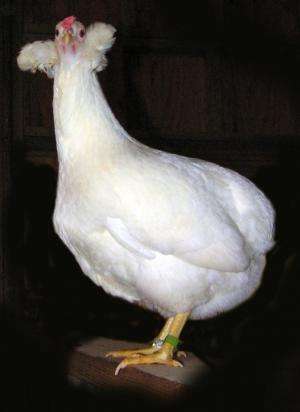Chickens offer clues to human birth defects

Clemson University researchers found that chicken eggs can provide a better understanding of human birth defects.
Susan Chapman, associate professor in Clemson's College of Agriculture, Forestry and Life Sciences, received a South Carolina IDeA Networks of Biomedical Research Excellence award that allowed researchers to identify two regions in the chicken genome that are associated with congenital deafness and spine deformities in humans.
Chapman examines the eggs from the Araucana breed of chicken, known as a popular show bird because for its ear tufts, rounded rump and blue eggs, each a result of a change, or mutation, in the DNA.
"Using eggs from these birds, we can learn which mutations influence normal development and then apply that knowledge to human health issues," said Chapman.
One mutation in the Araucana that the researchers identified causes failure of the final few vertebrae of the spine to form, which leads to the unusual "rumpless" bird that is a perennial favorite among show breeders. In humans, this results in a fairly severe defect, including lower-leg paralysis and urinary and bowel incontinence. However, the chicken mutation is not as severe and the birds live a normal, albeit tailless, life.
The researchers identified a region of mutations in the Araucana that lead to its rumplessness contain a family of genes that are important in making cells in the nervous system. These genes do not normally function in the region that gives rise to the tail, but in Araucana they are active, which changes the fate of the cells in the region. Because the cells in the mutant now become neurons rather than vertebral cells, the final vertebrae of the spine fail to form.
"This is important as it helps us understand how the spine normally forms and to identify a genetic cause when things go wrong, which in future could be tested for in people before they have children," Chapman said.
The researchers identified another mutation in the Araucana containing genes known to cause DiGeorge syndrome in humans, a disorder that results in the poor development of several body systems, including the facial bones, cleft palates, heart defects, poor immune system function, complications related to low levels of calcium in the blood and behavioral disorders.
The mutation in the Araucana lead to the formation of the ear tufts and abnormal middle ear blockages, causing conductive deafness. While the Araucana ear tufts look appealing, they hide the hearing defect that affects these birds.
The middle ear, which should normally have an air-filled cavity, instead is full of cellular tissue that causes conductive deafness because the middle ear bones cannot move and sound is not transmitted from the outside world to the inner ear.
"We know from this research that the genome region involved in the Araucana is the same as that causing DiGeorge syndrome in humans," said Chapman. "In the Araucana, the excess middle ear tissue is a specific defect that can act as a model for middle ear infections in children who also seem to have excess cells in the air-filled cavity of the middle ear."
Investigating the Araucana mutation is helping researchers understand how the embryo develops normally and offers reasons why the development process goes wrong and what potentially can be done to avoid or treat such conditions.
The long-term goal of this research is to offer options and therapies to families and health-care professionals faced with deafness, infections and birth defects.
















